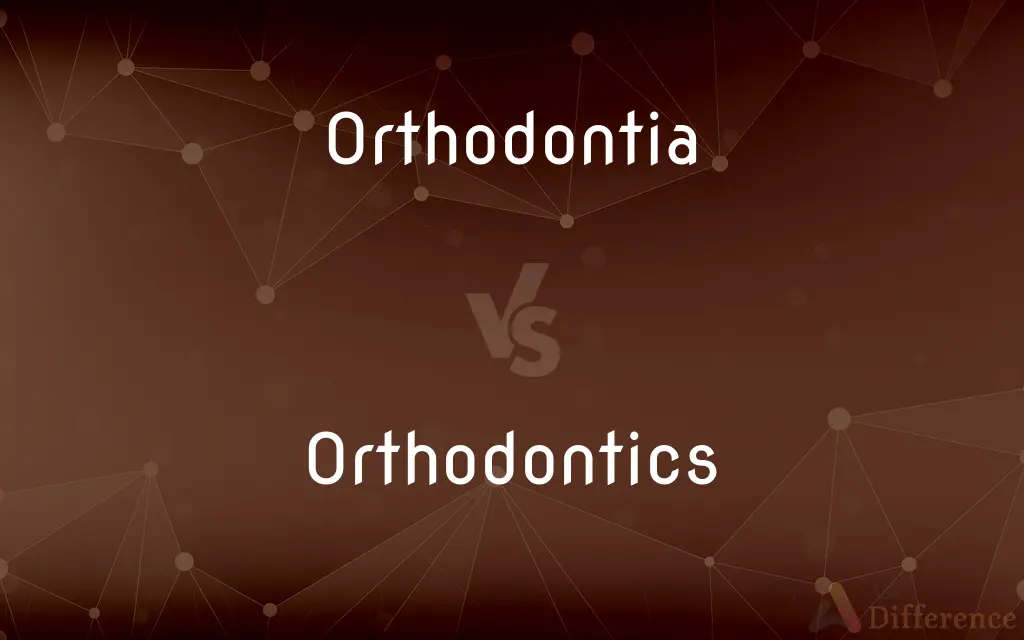Orthodontia vs. Orthodontics — What's the Difference?
By Fiza Rafique & Urooj Arif — Updated on March 13, 2024
Orthodontia is the field of dentistry focusing on correcting irregularities of the teeth and jaw, primarily through braces. Orthodontics is the broader term for the specialty within dentistry that includes diagnosis,and treatment of malocclusions.

Difference Between Orthodontia and Orthodontics
Table of Contents
ADVERTISEMENT
Key Differences
Orthodontia specifically refers to the practice and techniques used in the correction of misaligned teeth and jaws. This includes the use of braces, retainers, and other devices designed to align teeth and improve bite function. It focuses on the mechanical aspects of moving teeth and aligning jaws to achieve a harmonious balance between facial features and dental function. Orthodontics, on the other hand, encompasses orthodontia but also includes the study of the development of the teeth and jaws, the diagnosis of abnormalities, the planning of treatments, and the prevention of future dental issues. Orthodontics is the official term for this dental specialty recognized by dental associations and encompasses both the corrective techniques and the theoretical knowledge behind them.
Orthodontia is often considered a subset of orthodontics, with its primary focus on the application of corrective tools and procedures. Whereas orthodontics also involves the comprehensive assessment of facial growth and development, the etiology of malocclusions, and the preventive measures to avoid the development of such dental issues. For instance, orthodontics might involve interceptive measures in children to guide the proper growth of the jaw and the positioning of teeth, beyond just applying braces or other corrective devices.
Both orthodontia and orthodontics aim to improve oral health, function, and aesthetics. However, orthodontics provides a broader scope by including preventive and diagnostic responsibilities. An orthodontist, after completing dental school, undergoes additional specialized training in orthodontics to become proficient in both the theory and practice of this specialty, covering all aspects from orthodontia to comprehensive treatment planning and preventive advice.
The terms are often used interchangeably in casual conversation, but there is a distinction in professional contexts. While orthodontia focuses on the correction phase, orthodontics covers a wider spectrum, emphasizing the importance of understanding the underlying causes of dental irregularities, planning effective treatments, and preventing future issues through early intervention.
While orthodontia pertains specifically to the corrective techniques and devices used in treating dental and jaw irregularities, orthodontics is the broader discipline that includes the diagnosis, prevention, and treatment of these conditions. Both are integral to achieving and maintaining optimal oral health and aesthetics but differ in scope and focus.
ADVERTISEMENT
Comparison Chart
Definition
The practice and techniques for correcting misaligned teeth and jaws
The dental specialty that includes diagnosis, prevention, and treatment of dental and facial irregularities
Focus
Application of corrective devices like braces and retainers
Comprehensive care including etiology, development, and prevention of dental irregularities
Scope
Subset of orthodontics focusing on correction
Broad discipline covering theory, practice, and preventive care
Training
Part of orthodontic training, focuses on mechanical correction
Includes orthodontia but also covers diagnostic and preventive measures
Professional Recognition
Considered a practice within orthodontics
Recognized dental specialty by dental associations
Compare with Definitions
Orthodontia
Corrective dentistry.
Orthodontia has evolved to include invisible braces as a less noticeable option.
Orthodontics
Includes diagnosis and prevention.
Early orthodontics can prevent more severe issues later in life.
Orthodontia
Focuses on alignment.
Effective orthodontia improves both oral function and aesthetics.
Orthodontics
Comprehensive treatment.
Orthodontics involves more than just applying braces; it includes ongoing care and prevention.
Orthodontia
Uses devices.
Retainers are commonly used in orthodontia to maintain teeth position post-braces.
Orthodontics
Broader than orthodontia.
His studies in orthodontics cover everything from corrective techniques to facial growth theories.
Orthodontia
Subset of orthodontics.
Her interest in orthodontia led her to specialize in orthodontics.
Orthodontics
Dental specialty.
Orthodontics is recognized as a specialty by dental associations worldwide.
Orthodontia
Aims for harmony.
Orthodontia seeks to achieve a balance between facial features and dental structure.
Orthodontics
Covers growth and development.
Orthodontics studies the impact of jaw growth on teeth alignment.
Orthodontia
Orthodontics.
Orthodontics
Orthodontics is a dentistry specialty that addresses the diagnosis, prevention, and correction of mal-positioned teeth and jaws, and misaligned bite patterns. It may also address the modification of facial growth, known as dentofacial orthopedics.
Orthodontia
Synonym of orthodontics
Orthodontics
(used with a sing. verb) The dental specialty dealing with correction of irregularities of the teeth, such as malocclusion, often by the use of braces.
Orthodontia
The treatment of the teeth so as to make the teeth align properly within the mouth, usually involving the wearing of braces and sometimes oral surgery.
Orthodontics
(medicine) A specialty of dentistry concerned with correcting misalignment of teeth.
Orthodontia
The branch of dentistry dealing with the prevention or correction of irregularities of the teeth
Orthodontics
A branch of dentistry specializing in the treatment of the teeth so as to make the teeth align properly within the mouth; it usually involves fitting a patient with braces and sometimes oral surgery.
Orthodontics
The branch of dentistry dealing with the prevention or correction of irregularities of the teeth
Common Curiosities
Is orthodontia just about wearing braces?
While braces are a common aspect of orthodontia, it also includes the use of other devices and techniques to correct dental and jaw alignments.
How does orthodontics differ from general dentistry?
Orthodontics is a specialty within dentistry focused on diagnosing, preventing, and treating dental and facial irregularities, requiring additional training beyond general dentistry.
What is the goal of orthodontia?
The goal of orthodontia is to correct misalignments of the teeth and jaws to improve oral function and aesthetics.
How do preventive measures in orthodontics work?
Preventive orthodontics may involve interventions to guide jaw growth, ensure adequate space for permanent teeth, and prevent malocclusions before they fully develop.
What advancements have been made in orthodontia?
Advances in orthodontia include the development of clear aligners, lingual braces, and other less visible corrective devices.
Why might someone need orthodontic treatment?
Individuals may need orthodontic treatment to correct irregularities that affect their bite, oral health, or appearance, improving both function and self-esteem.
What is the importance of early orthodontic evaluation?
Early evaluation allows for the identification of potential problems and the implementation of preventive or interceptive measures to simplify or avoid future orthodontic treatment.
What types of problems do orthodontics address?
Orthodontics addresses a wide range of issues, including crowded or spaced teeth, overbites, underbites, crossbites, and the impact of jaw growth on teeth alignment.
Can all dentists perform orthodontic treatments?
While all dentists receive basic training in orthodontic care, only those with additional specialized training in orthodontics are recognized as orthodontists.
Can youngs benefit from orthodontics?
Yes, youngs can benefit from orthodontics, as treatments can be effective at any age, improving oral health and aesthetics.
Share Your Discovery

Previous Comparison
Sumptuous vs. Rich
Next Comparison
Tease vs. RagAuthor Spotlight
Written by
Fiza RafiqueFiza Rafique is a skilled content writer at AskDifference.com, where she meticulously refines and enhances written pieces. Drawing from her vast editorial expertise, Fiza ensures clarity, accuracy, and precision in every article. Passionate about language, she continually seeks to elevate the quality of content for readers worldwide.
Co-written by
Urooj ArifUrooj is a skilled content writer at Ask Difference, known for her exceptional ability to simplify complex topics into engaging and informative content. With a passion for research and a flair for clear, concise writing, she consistently delivers articles that resonate with our diverse audience.















































